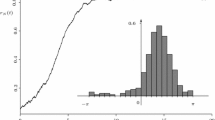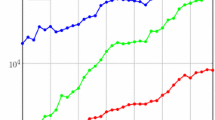Abstract
With the aim of considering models related to random graphs growth exhibiting persistent memory, we propose a fractional nonlinear modification of the classical Yule model often studied in the context of macroevolution. Here the model is analyzed and interpreted in the framework of the development of networks such as the World Wide Web. Nonlinearity is introduced by replacing the linear birth process governing the growth of the in-links of each specific webpage with a fractional nonlinear birth process with completely general birth rates. Among the main results we derive the explicit distribution of the number of in-links of a webpage chosen uniformly at random recognizing the contribution to the asymptotics and the finite time correction. The mean value of the latter distribution is also calculated explicitly in the most general case. Furthermore, in order to show the usefulness of our results, we particularize them in the case of specific birth rates giving rise to a saturating behaviour, a property that is often observed in nature. The further specialization to the non-fractional case allows us to extend the Yule model accounting for a nonlinear growth.



Similar content being viewed by others
References
Abramowitz, M., Stegun, I.A. (eds.): Handbook of Mathematical Functions with Formulas, Graphs, and Mathematical Tables. Dover Publications Inc, New York (1992). ISBN 0-486-61272-4. Reprint of the 1972 edition
Bailey, N.T.J.: The Elements of Stochastic Processes with Applications to the Natural Sciences. Wiley, New York (1964)
Barabási, A.-L., Albert, R.: Emergence of scaling in random networks. Science 286(5439), 509–512 (1999). doi:10.1126/science.286.5439.509
Beghin, L., D’Ovidio, M.: Fractional Poisson process with random drift. Electron. J. Probab. 19(19), 26 (2014). doi:10.1214/EJP.v19-3258
Beghin, L., Orsingher, E.: Fractional Poisson processes and related planar random motions. Electron. J. Probab. 14(61), 1790–1827 (2009). doi:10.1214/EJP.v14-675
Bertoin, J.: Lévy Processes, volume 121 of Cambridge Tracts in Mathematics. Cambridge University Press, Cambridge (1996). ISBN 0-521-56243-0
Bollobás, B., Riordan, O., Spencer, J., Tusnády, G.: The degree sequence of a scale-free random graph process. Random Struct. Algorithms 18(3), 279–290 (2001)
Cahoy, D.O., Polito, F.: On a fractional binomial process. J. Stat. Phys. 146(3), 646–662 (2012a). doi:10.1007/s10955-011-0408-3
Cahoy, D.O., Polito, F.: Simulation and estimation for the fractional Yule process. Methodol. Comput. Appl. Probab. 14(2), 383–403 (2012b). doi:10.1007/s11009-010-9207-6
Cahoy, D.O., Polito, F.: Renewal processes based on generalized Mittag-Leffler waiting times. Commun. Nonlinear Sci. Numer. Simul. 18(3), 639–650 (2013). doi:10.1016/j.cnsns.2012.08.013
Cahoy, D.O., Polito, F.: Parameter estimation for fractional birth and fractional death processes. Stat. Comput. 24(2), 211–222 (2014). doi:10.1007/s11222-012-9365-1
Crump, K.S.: On point processes having an order statistic structure. Sankhyā Ser. A 37(3), 396–404 (1975)
Dereich, S., Mönch, C., Mörters, P.: Distances in scale free networks at criticality. arXiv preprint arXiv:1604.00779 (2016)
Diethelm, K.: The Analysis of Fractional Differential Equations. In: An application-oriented exposition using differential operators of Caputo type. Lecture Notes in Mathematics, vol. 2004. Springer-Verlag, Berlin (2010). ISBN 978-3-642-14573-5. doi:10.1007/978-3-642-14574-2
Dorogovtsev, S.N., Mendes, J.F.F., Samukhin, A.N.: Structure of growing networks with preferential linking. Phys. Rev. Lett. 85, 4633–4636 (2000)
Feigin, P.D.: On the characterization of point processes with the order statistic property. J. Appl. Probab. 16(2), 297–304 (1979)
Garra, R., Gorenflo, R., Polito, F., Tomovski, Ž.: Hilfer-Prabhakar derivatives and some applications. Appl. Math. Comput. 242, 576–589 (2014). doi:10.1016/j.amc.2014.05.129
Garra, R., Orsingher, E., Polito, F.: State-dependent fractional point processes. J. Appl. Probab. 52(1), 18–36 (2015). doi:10.1239/jap/1429282604
Gorenflo, R., Kilbas, A.A., Mainardi, F., Rogosin, S.V.: Mittag-Leffler Functions. Related Topics and Applications. Springer Monographs in Mathematics. Springer, Heidelberg (2014). ISBN 978-3-662-43929-6; 978-3-662-43930-2. doi:10.1007/978-3-662-43930-2
Johnson, N.L., Kemp, A.W., Kotz, S.: Univariate Discrete Distributions. Wiley Series in Probability and Statistics. Wiley-Interscience [John Wiley & Sons], Hoboken, NJ, third edition (2005). ISBN 978-0-471-27246-5; 0-471-27246-9. doi:10.1002/0471715816
Kilbas, A.A., Srivastava, H.M., Trujillo, J.J.: Theory and Applications of Fractional Differential Equations, vol. 204 of North-Holland Mathematics Studies. Elsevier Science B.V., Amsterdam, (2006). ISBN 978-0-444-51832-3; 0-444-51832-0
Krapivsky, P.L., Redner, S.: Finiteness and fluctuations in growing networks. J. Phys. A 35(45), 9517 (2002)
Krapivsky, P.L., Redner, S., Leyvraz, F.: Connectivity of growing random networks. Phys. Rev. Lett. 85(21), 4629 (2000)
Kyprianou, A.E.: Fluctuations of Lévy Processes with Applications, 2nd edn. Universitext. In: Introductory lectures. Springer, Heidelberg (2014). ISBN 978-3-642-37631-3; 978-3-642-37632-0. doi:10.1007/978-3-642-37632-0
Lansky, P., Polito, F., Sacerdote, L.: The role of detachment of in-links in scale-free networks. J. Phys. A 47(34), 345002 (2014)
N. Laskin.: Fractional Poisson process. Commun. Nonlinear Sci. Numer. Simul. 8(3–4), 201–213 (2003). doi:10.1016/S1007-5704(03)00037-6
Mainardi, F., Gorenflo, R., Scalas, E.: A fractional generalization of the Poisson processes. Vietnam J. Math. 32(Special Issue), 53–64 (2004)
Maruvka, Y.E., Shnerb, N.M., Kessler, D.A., Ricklefs, R.E.: Model for macroevolutionary dynamics. Proc. Natl Acad. Sci 110(27), E2460–E2469 (2013)
Meerschaert, M.M., Nane, E., Vellaisamy, P.: The fractional Poisson process and the inverse stable subordinator. Electron. J. Probab. 16(59), 1600–1620 (2011). doi:10.1214/EJP.v16-920
Neuts, M.F., Resnick, S.I.: On the times of births in a linear birthprocess. J. Aust. Math. Soc. 12, 473–475 (1971)
Olver, F.W.J., Lozier, D.W., Boisvert, R.F., Clark, C.W. (eds): NIST Handbook of Mathematical Functions. U.S. Department of Commerce, National Institute of Standards and Technology, Washington, DC; Cambridge University Press, Cambridge (2010). ISBN 978-0-521-14063-8. With 1 CD-ROM (Windows, Macintosh and UNIX)
Orsingher, E., Polito, F.: Fractional pure birth processes. Bernoulli 16(3), 858–881 (2010). doi:10.3150/09-BEJ235
Orsingher, E., Polito, F.: The space-fractional Poisson process. Stat. Probab. Lett. 82(4), 852–858 (2012). doi:10.1016/j.spl.2011.12.018
Orsingher, E., Polito, F.: Randomly stopped nonlinear fractional birth processes. Stoch. Anal. Appl. 31(2), 262–292 (2013). doi:10.1080/07362994.2013.759495
Pachon, A., Polito, F., Sacerdote, L.: Random graphs associated to some discrete and continuous time preferential attachment models. J. Stat. Phys. 162(6), 1608–1638 (2016). doi:10.1007/s10955-016-1462-7
Politi, M., Kaizoji, T., Scalas, E.: Full characterization of the fractional Poisson process. EPL (Europhys. Lett.) 96(2), 20004 (2011)
Puri, P.S.: On the characterization of point processes with the order statistic property without the moment condition. J. Appl. Probab. 19(1), 39–51 (1982)
Reed, W.J., Hughes, B.D.: On the size distribution of live genera. J. Theor. Biol. 217(1), 125–135 (2002)
Simkin, M.V., Roychowdhury, V.P.: Re-inventing willis. Phys. Rep. 502(1), 1–35 (2011). doi:10.1016/j.physrep.2010.12.004
Simon, H.A.: On a class of skew distribution functions. Biometrika 42, 425–440 (1955)
Uchaikin, V.V., Cahoy, D.O., Sibatov, R.T.: Fractional processes: from Poisson to branching one. Int. J. Bifur. Chaos Appl. Sci. Eng. 18(9), 2717–2725 (2008). doi:10.1142/S0218127408021932
Yule, G.U.: A mathematical theory of evolution, based on the conclusions of Dr. J. C. Willis, FRS. Philosophical Transactions of the Royal Society of London. Series B, Containing Papers of a Biological Character, pp. 21–87 (1925)
Acknowledgments
P. Lansky was supported by the Czech Science Foundation project 15-06991S. L. Sacerdote and F. Polito were supported by the projects “Application driven Markov and non Markov models” and “Stochastic modelling beyond diffusions” (Università degli Studi di Torino), and by INDAM.
Author information
Authors and Affiliations
Corresponding author
Appendix 1
Appendix 1
For the sake of self-containedness we give here a brief description of the fractional nonlinear birth process. For a quick comparison with the classical nonlinear birth process see Table 1.
Let us consider a population of individuals developing with continuous time t initiated by one single initial progenitor at time \(t=0\). We indicate the random number of individuals in the population for any fixed time t with the random variable \(\mathfrak {N}^\nu (t)\). It is known [32] that the state probabilities \(p_n^\nu (t) = \mathbb {P}(\mathfrak {N}^\nu (t)=n)\), \(n \ge 1\), satisfy the system of difference-differential equations
where \(p_0^\nu (s)=0\). Moreover, \(p_n^\nu (0) =\delta _{n,1}\), that is the process starts with only one initial progenitor, and the fractional derivative is the Caputo derivative (see e.g. [14, 21]). Briefly, the Caputo derivative is an integral operator of convolution-type with a singular power-law kernel. The Caputo derivative can be defined in several equivalent ways. We consider here the following form:
Definition 5.1
(Caputo derivative) Let \(\alpha >0\), \(m = \lceil \alpha \rceil \), and \(f \in AC^m[a,b]\). The Caputo derivative of order \(\alpha >0\) is defined as
In our case we have \(\alpha =\nu \in (0,1)\), \(m=1\), \(a=0\), obtaining
It is evident from the above Definition 5.1 that the Caputo derivative is a non-local operator in the sense that the integration over the interval (0, t) furnishes the system with a persistent memory. Roughly speaking the first order derivative \(\frac{d }{d s}p_n^\nu (s)\) is evaluated along the whole time interval (0, t) and weighted by means of the power-law kernel.
The state probabilities \(p_n^\nu (t)\) of the fractional birth process can be explicitly determined and (with the convention that empty products equal unity) have the form (for the nonlinear rates \(\lambda _j\), \(j \ge 1\), all different) [32]
where \(E_{\nu } (\zeta )\) is the so-called Mittag–Leffler function, a special function defined as
and having Laplace transform
The state probabilities (5.4) can be actually derived by means of an iterated application of the Laplace transform on the equations (5.1) starting from \(n=1\). For details on this point see [32], Sect. 2. The Mittag–Leffler function (5.5) is in practice a generalization of the exponential function in the sense that \(E_{1} \left( \zeta \right) = \exp (\zeta )\). General properties of the Mittag–Leffler functions are contained in many classical reference books and articles (see e.g. the very recent monograph [19] and the references listed therein).
In the present paper we will often make use of the Laplace transform of the state probabilities (5.4) of the fractional nonlinear birth process. From [32, 34] we we can easily check that that
If the rates are all different, equation (5.7) can be written as
that is a more manageable form for the purpose of specializing the rates.
For more insights on the properties of the fractional nonlinear birth process see [32, 34]. Here we conclude this section by recalling an interesting representation of the fractional nonlinear birth process as a time-changed process and by giving some details of the specific case in which the rates are linear. Regarding the first point the fractional nonlinear birth process can be constructed as a classical birth process stopped at an independent random time given by the inverse process to an independent \(\nu \)-stable subordinator. Notice that stable subordinators are increasing spectrally positive Lévy processes with Lévy measure given by \(m(d x)= \left[ \nu /\Gamma (1-\nu ) \right] x^{-1-\nu }d x\). For more details on this last point see [6, 24].
An interesting particular case is when the rates are linear, i.e. \(\lambda _r=\lambda r\). Here the state probability distribution (5.4) specializes in the rather simple form
The geometric distribution of the linear birth process (also known as Yule or Yule–Furry process and indicated in the paper with \(\mathfrak {N}^\nu _{\text {lin}}(t)\), \(t \ge 0\)) is retrieved from (5.9) if the parameter \(\nu \) is taken equal to unity. Properties of the fractional Yule process have been studied in [32, 41] while estimators for the intensity \(\lambda \) and the fractional parameter \(\nu \) have been derived in [9, 11].
Rights and permissions
About this article
Cite this article
Lansky, P., Polito, F. & Sacerdote, L. Generalized Nonlinear Yule Models. J Stat Phys 165, 661–679 (2016). https://doi.org/10.1007/s10955-016-1630-9
Received:
Accepted:
Published:
Issue Date:
DOI: https://doi.org/10.1007/s10955-016-1630-9




